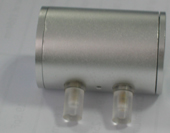
 |
|
|
|
Laser Components  Pockel Cell Pockel Cell BBO Pockel Cell
BBO Pockel Cell
|
Introduction
| |
BBO is the electro-optic
material of choice for high average power Pockels
cell applications. 
BBO has significant advantages over other materials
in terms of laser power handling abilities, temperature
stability, and substantial freedom from piezoelectric
ringing. Because it relies on the electro optic
effect, switching time — aided by the low capacitance
of the Pockels cell — is very fast. The wide transparency
range of BBO allows it to be used in diverse applications.
|
|
Electro-optic Pockels cells are used in applications that require fast switching of the polarization direction of a beam of light. These uses include Q-switching of laser cavities, coupling light into and out from regenerative amplifiers, and, when used in conjunction with a pair of polarizers, light intensity modulation. Pockels cells are characterized by fast response,
since the Pockels Effect is largely an electronic effect
that produces a linear change in refractive index when
an electric field is applied, and are much faster in
response than devices based on acoustic changes in a
material, for example. |
Because of crystal symmetry and the desire for the
light beam to experience no birefringence in the absence
of an electric field, BBO Pockels cells are transverse-field
devices.
The quarter-wave voltage is V/4 = d / (4 r22 no3 l).
The quarter-wave voltage is proportional to d/l, the
electrode spacing divided by the crystal length, is
inversely proportional to the electro-optic coefficien
r22, and decreases when operated at shorter wavelengths,
.
Piezoelectric ringing in BBO is small, as evidenced
by comparison to KD*P and LiNbO3 Pockels cells. Transmission
of a test laser beam at 633 nm, with the Pockels cell
placed between parallel polarizers, is shown in the
following oscilloscope traces. Application of the quarter-wave
voltage for each cell caused the transmitted light intensity
to decrease to one-half. Operation at the quarter-wave
voltage accentuates the appearance of acoustic ringing.
In the traces, the 1 indicates ground or zero light
intensity. Plots are shown using KD*P, LiNbO3, and BBO
as the Pockels cell material.
Clearly, ringing associated with use of BBO
is much less than when either KD*P or LiNbO3 is
used. The last trace shows the transmission with
BBO in the typical double-pass configuration at
the quarter-wave voltage, switching at 5 kHz —
the maximum rate allowed by the high voltage driver
that was used. In this last trace, intensity is
a maximum when voltage is applied; the bottom
trace was taken with the laser beam blocked. |
|
Advanced:
 High Repetition Rate High Repetition Rate
 Low Acoustic Noise Low Acoustic Noise
 Damage Resistant Ceramic Apertures Damage Resistant Ceramic Apertures
 High Average Power Applications High Average Power Applications
 Compact Design Compact Design
 Lower Voltage Requirements
Than Other BBO Cells Lower Voltage Requirements
Than Other BBO Cells
 Suitable for Q-switch and Regen-amp
Applications Suitable for Q-switch and Regen-amp
Applications
|
BBO
Pockels Cell Specifications:
| Aperture Diameter |
3.5 mm |
2.5 mm |
| Quarter-Wave Voltage |
4.8Kv |
3.6Kv |
Intrinsic Contrast
@ 1064 nm
|
> 1000 : 1 |
| Optical Transmission |
> 98 % T |
| Repetition Ratio |
<100kHz |
Damage Threshold*
(Nanosecond Pulses)
|
> 500 MW / cm2 |
Damage Threshold*
(cw Power)
|
> 3 kW / cm2 |
Wavefront Distortion
@ 1064 nm
|
< l/8 |
| Electrical Contacts |
two, electrically floating,
miniature banana plugs |
| Typical Capacitance |
3 pF |
| Outline Dimensions |
1" Diameter x 2"
Long Cylinder |
|
|
|



